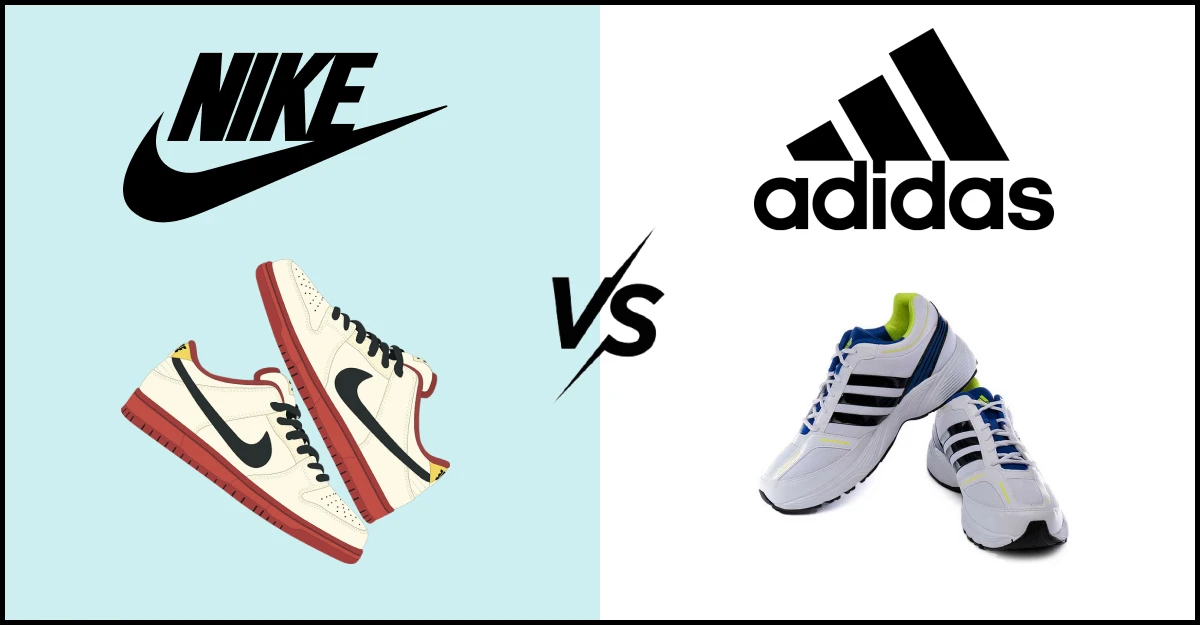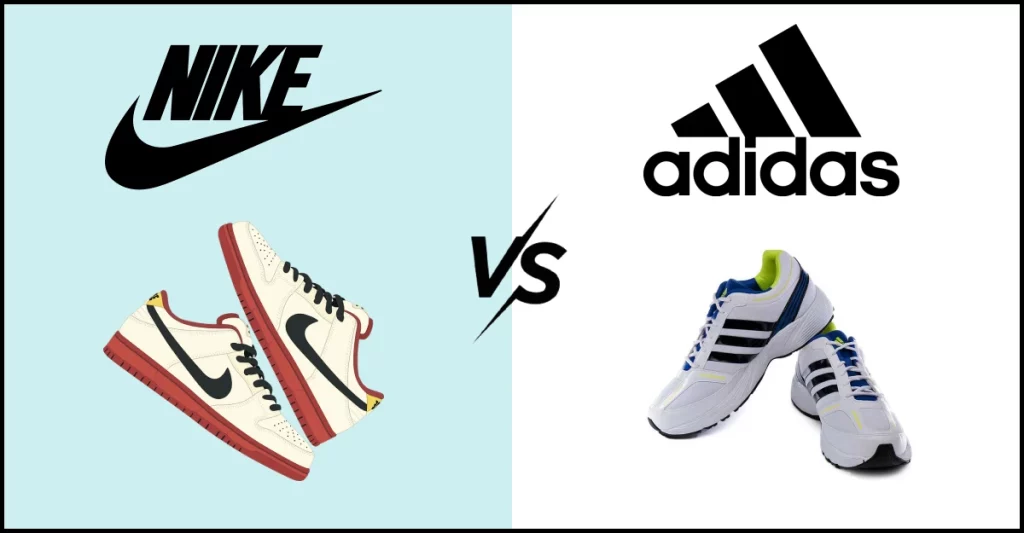When we talk about sneakers, sports shoes, clothes for sports, or sporty outfits, there are two big brand names that come up a lot. They are in fierce competition with each other. Can you guess which ones? It’s Nike vs Adidas!

Nike and Adidas are well-known companies from the United States and Europe. They have been popular for a long time for their sneakers and sportswear. Almost everyone has heard of these two brands. They both make sporty clothes and specialize in shoes.
Although Nike is much bigger financially than Adidas, Adidas has been doing better in recent years. So, which one is better and leading the market? Are you curious to find out? Stick with this article because we’ll discuss various factors to determine the winner in the Nike vs Adidas battle.
Stay tuned!
(A) Global Business Comparison
As per recent reports, the brand value of Nike has been increasing year-on-year since 2010 and will reach around 50 billion U.S. dollars in 2022. In comparison, the brand value of Adidas was valued at approximately 16 billion U.S. dollars in 2022 – increasing for the sixth consecutive year following two years of decline.
Let’s look at the data-
| Particulars | Nike | Adidas |
| Brand Value | $50 billion | $16 billion |
| Number of Stores Worldwide | 1,096 | 2,456 |
| Revenue from North America (%) | 41% | 24% |
| Market Share | 65.9% | 14.7% |
It’s worth noting that Nike generates around 41% of its total revenue from North America, whereas around 24% of Adidas’ global revenue comes from North America.
(B) Market Share Comparison in Leading Countries
Let’s compare the market share of Nike vs Adidas through their percentage of sales in leading countries-
| Regions | Nike | Adidas |
| North America | 45% | 21% |
| Western Europe | 18% | 29% |
| Central & and Eastern Europe | 4% | 3% |
| Greater China | 12% | 19% |
| Japan | 3% | 5% |
| Emerging Markets | 12% | 9% |
| Remaining | 6% | 14% |
Predictably, Nike and Adidas predominantly rely on Asian sources for the bulk of their production, albeit Adidas places a slightly greater emphasis on manufacturing within this region compared to Nike. As anticipated, Nike’s production is more pronounced in the Americas, while Adidas boasts a greater presence in Europe. Africa, meanwhile, contributes only minimally to the overall manufacturing operations of both companies.
(C) Nike vs Adidas: Key Differences
Let’s look at the major differences in the battle of Nike vs Adidas-
| Characteristic Features | Nike | Adidas |
| Logo | Swoosh | Three Stripes |
| Origin | USA | Germany |
| Founded | 1964 | 1949 |
| Founders | Bill Bowerman Phil Knight | Adolf Dassler |
| Headquarters | Washington, USA | Herzogenaurach, Germany |
| Brand Slogan | “Just do it” | “Impossible is nothing” |
| Primary Focus | Innovation and Performance | Lifestyle and Sportswear |
| Athlete Endorsements | Extensive, inclusive Michael Jordan | Notable athletes like Messy, Kanye West |
| Areas Served | Worldwide | Worldwide |
| Design Philosophy | Modern and sleek | Classic and timeless |
| Product Range | Athletic shoes, Athletic Apparel, Sporting goods, Accessories. | Apparel, Footwear, Sportswear, Sports, Equipment, Toiletries |
| Market Capitalization | $147.85 billion (2023) | EUR 30.50 billion (2023) |
| Revenue | $46.71 billion (2022) | EUR 21.915 billion (2018) |
You can’t declare the winner of Nike vs Adidas just by looking at the table. We need to analyze both companies deeply. You must look at the individual company’s specialties and drawbacks. And then you will know which one is better and ruling the market.
(D) Nike’s Specialties and Drawbacks
Let’s have a brief overview of Nike’s specialties and drawbacks before diving into the details-
| Specialties | Drawbacks |
| Innovative Technology | High Prices |
| Extensive Athlete Endorsements | Ethical Concerns |
| Strong Brand Identity | Limited Sustainable Options and Competition |
| Wide Product Range | Counterfeit Products |
| Global Presence | Some controversial Campaigns |
(D.1) Nike’s Specialties
First of all, let’s look at the specialties of Nike-
Innovative Technology
Nike is at the forefront of integrating innovative technology into its products. They have developed technologies like Nike Air cushioning, Nike React foam, and Flyknit material, which enhance the performance and comfort of their athletic footwear.
Extensive Athlete Endorsements
Nike boasts a long history of partnerships with top-tier athletes, including Michael Jordan, LeBron James, and Cristiano Ronaldo. These endorsements contribute to Nike’s image as a leader in sports performance.
Strong Brand Identity
The iconic Nike Swoosh logo and the “Just Do It” slogan are synonymous with athleticism and determination. They have become powerful symbols recognized worldwide, contributing to the brand’s allure.
Wide Product Range
Nike offers an extensive array of products beyond footwear, including sportswear, activewear, and accessories. This diverse range appeals to a broad consumer base, from athletes to fashion-conscious individuals.
Global Presence
Nike’s global footprint is extensive, with a widespread network of retail stores, online sales, and a presence in various countries. This global reach has solidified its status as a leading sportswear brand.
(D.2) Nike’s Drawbacks
Here are the few drawbacks of Nike that immensely impact its sales-
High Prices
Nike’s commitment to quality often results in premium pricing, making their products less accessible to budget-conscious consumers. This factor limits their market reach.
Ethical Concerns
Nike has faced criticism and controversy over labor practices in some of its overseas manufacturing facilities. Allegations of poor working conditions and low wages have raised ethical concerns in the past.
Limited Sustainable Options
While Nike has made strides in sustainability efforts, they still face challenges in reducing their environmental impact. Some consumers seek more eco-friendly alternatives and find Nike’s offerings lacking in this regard.
Competition: Who is Nike’s biggest Competition?
It’s Adidas! Nike faces fierce competition in the sportswear industry, especially from Adidas. Maintaining market share and brand visibility is challenging in such a competitive landscape.
Frequent Counterfeits
Due to its popularity, Nike products are frequently counterfeited. This not only affects the brand’s reputation but also poses risks to consumers who unknowingly purchase counterfeit items.
Quality Control Challenges
Occasionally, Nike has encountered quality control issues with certain product lines. Instances of manufacturing defects or product recalls lead to customer dissatisfaction and damage the brand’s image.
Some Controversial Campaigns
Nike’s advertising campaigns, while often impactful, have sometimes sparked controversy or public debate. For example, their endorsement of Colin Kaepernick in the “Just Do It” campaign generated significant discussion and polarized opinions.
(E) Adidas Specialties and Drawbacks
Let’s have a brief overview of Adidas’ specialties and drawbacks before diving into the details-
| Adidas Specialties | Drawbacks |
| Heritage & Legacy | Quality concerns |
| Three Stripes Logo | Price Point |
| Influencing Collaborations | Competition |
| Lifestyle Appeal | Brand Overextension |
| Sustainable Initiatives | Labor Practices |
| Innovation and Performance | Limited Customization |
(E.1) Specialties of Adidas
The specialties of Adidas are described below-
Heritage & Legacy
Adidas, founded in 1949 in Germany, has a rich history and heritage in the sportswear industry. This legacy contributes to its strong brand recognition and reputation.
Three Stripes Logo
The iconic three-stripe logo is synonymous with Adidas and is instantly recognizable globally, helping to establish a strong brand identity.
Innovation and Performance
Adidas continually invests in innovative technologies such as Boost cushioning and Primeknit materials. These innovations are incorporated into their products to enhance comfort and performance for athletes and consumers.
Influencing Collaborations
Adidas collaborates with high-profile athletes like Lionel Messi, Kanye West, and Beyoncé, creating exclusive lines and generating significant brand buzz.
Note: Recently, Adidas partnered with the Indian cricket team for sponsorship. We have covered it in the article “Adidas & Indian Cricket Team.” Check it out for detailed information.
Lifestyle Appeal
While known for sportswear, Adidas has successfully expanded into the lifestyle market, with fashion-forward designs that appeal to consumers beyond sports enthusiasts.
Sustainability Initiatives
Adidas has made efforts to improve sustainability, using recycled materials in some products and committing to reducing its environmental footprint. Initiatives like the “Futurecraft Loop” demonstrate a commitment to circular design.
(E.2) Drawbacks of Adidas
The drawbacks of Adidas involves the following-
Quality Concerns
Some consumers have raised concerns about the quality of certain Adidas products, particularly when compared to competitors like Nike. This includes issues with durability and comfort.
Price Point
Adidas products are relatively expensive, which limits accessibility for price-conscious consumers. This high pricing is especially true for limited-edition or celebrity-endorsed items.
Competition
Adidas faces fierce competition in the sportswear industry, especially from Nike. Maintaining market share and brand visibility is challenging in such a competitive landscape.
Brand Overextension
While expanding into various categories can be advantageous, Adidas’ wide product range can sometimes dilute its brand identity, making it harder for consumers to associate the brand with a specific image or product.
Labor Practices
Like many global apparel manufacturers, Adidas has faced scrutiny over labor practices in its supply chain. Ensuring ethical and fair labor conditions in all manufacturing facilities remains a challenge.
Limited Customization
Adidas offers less product customization compared to some competitors. Consumers who desire highly personalized products might find this limiting.
(F) Final Words: Which one is better in Nike vs Adidas?
Nike and Adidas stand out as prominent players in the realm of footwear and sports accessories. Irrespective of our origins, many of us are naturally drawn to these renowned brands for our sporting needs, be it footwear or more.

Nike possesses a distinct advantage over its rival, Adidas. It commands a commanding 50% share of the sportswear market. Nike’s success can be attributed to its compelling advertising campaigns and influential celebrity endorsements, including its partnership with Michael Jordan. These factors enable Nike to outpace its German counterpart, Adidas, in terms of market share, revenue, and profits. On the other hand, Adidas, while holding a smaller market share, is highly esteemed by its global user base for its product quality and durability. Founded in 1949, this German brand boasts a long-standing presence in the sportswear industry.
In essence, the choice between Adidas and Nike is subjective and hinges on personal preference. Both companies enjoy stellar reputations and offer top-tier products. Ultimately, the decision of which brand to embrace rests with the individual, taking into account their unique style, comfort, and performance requirements.

